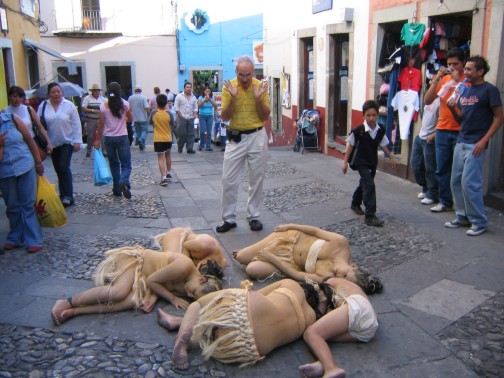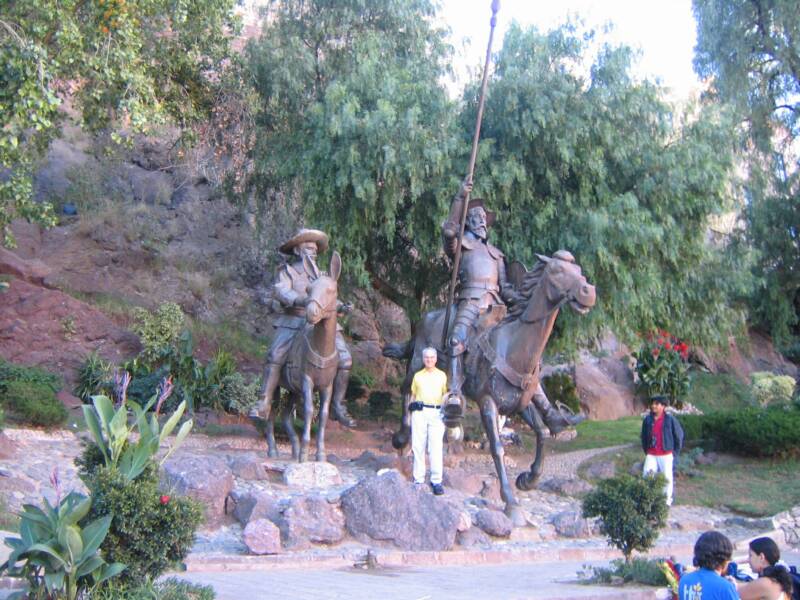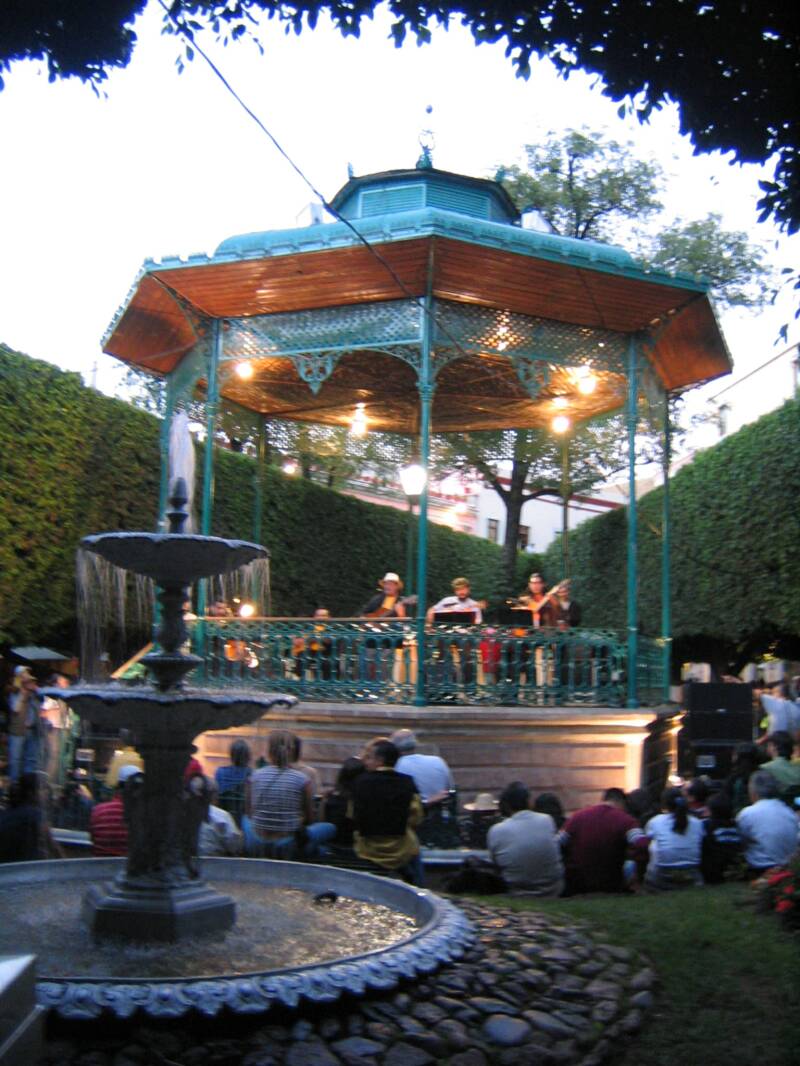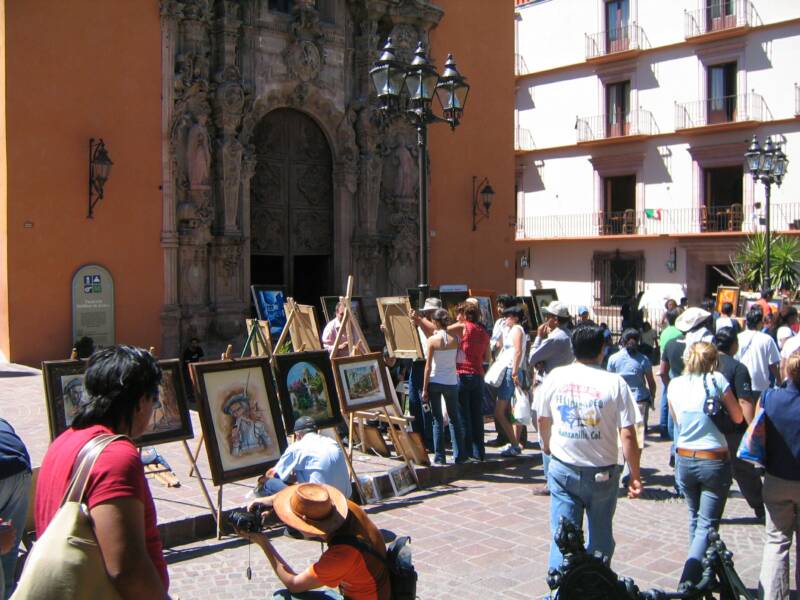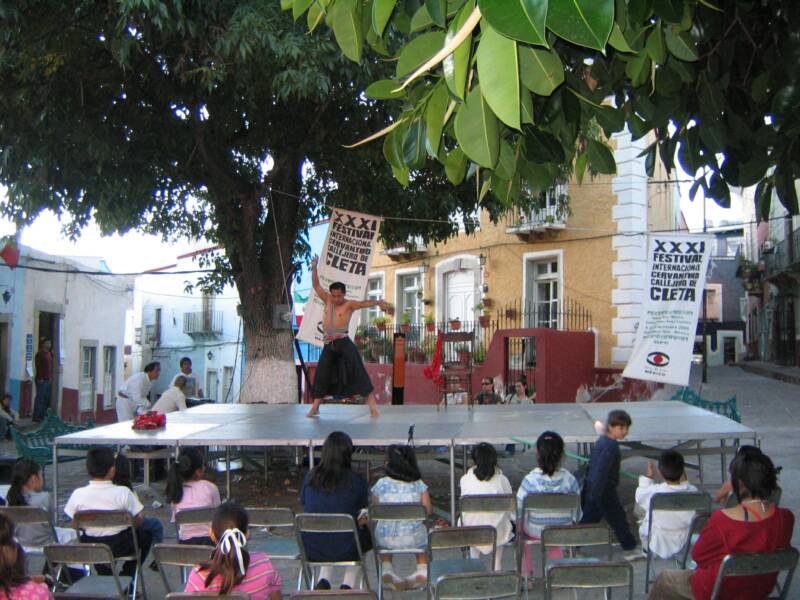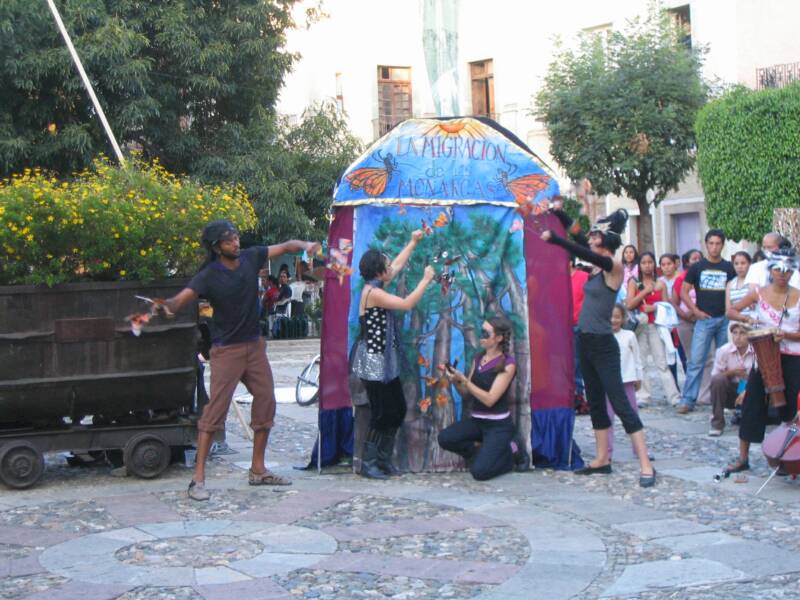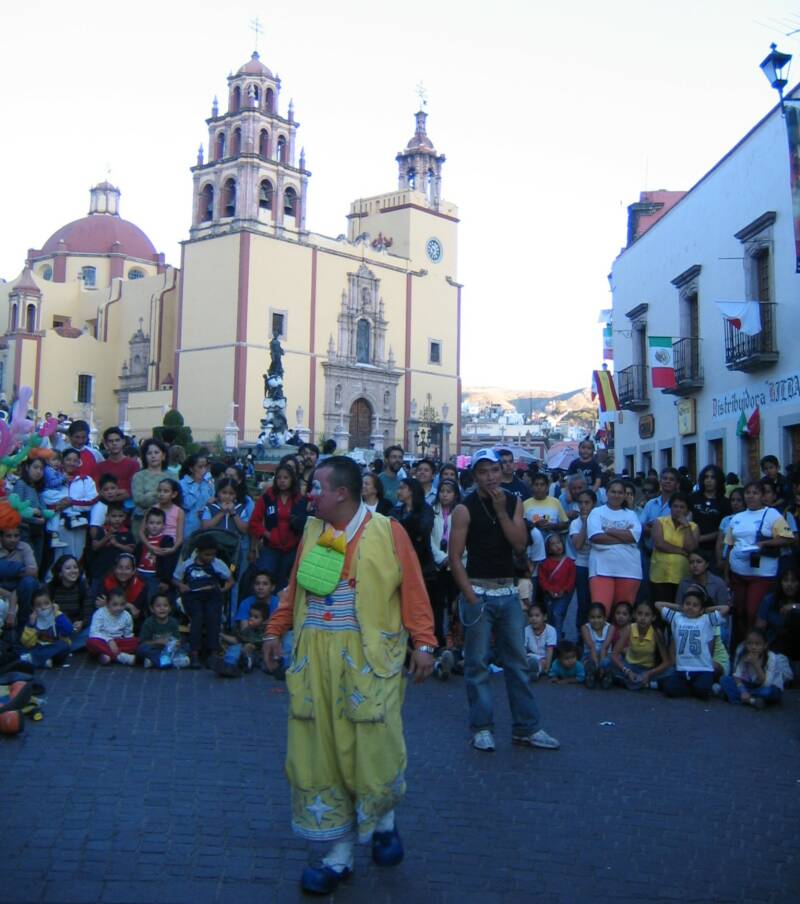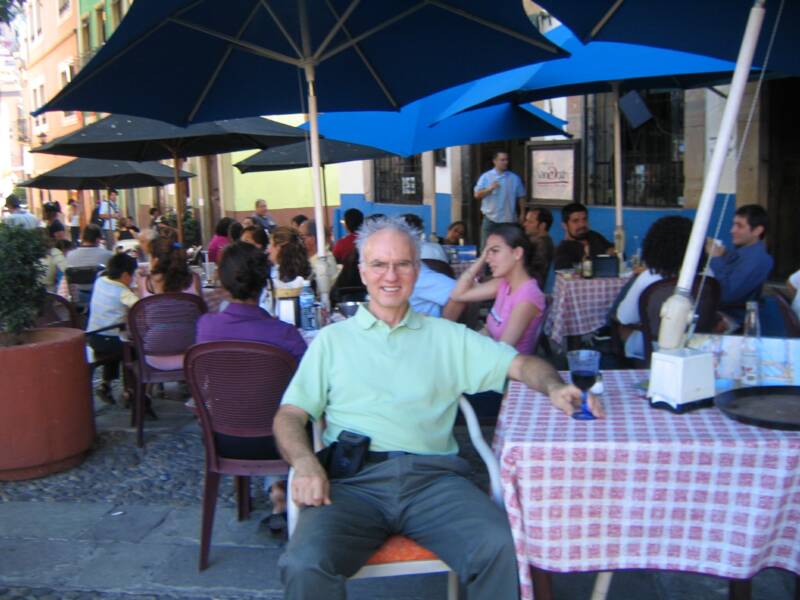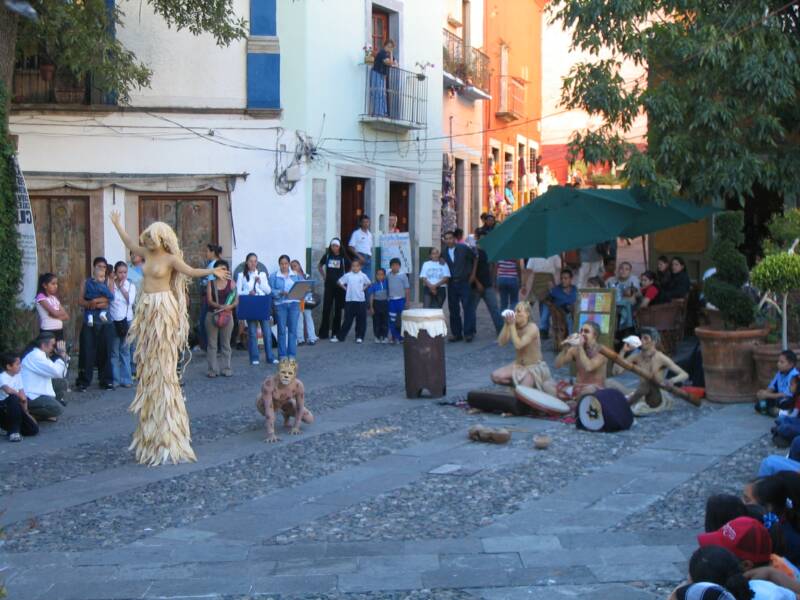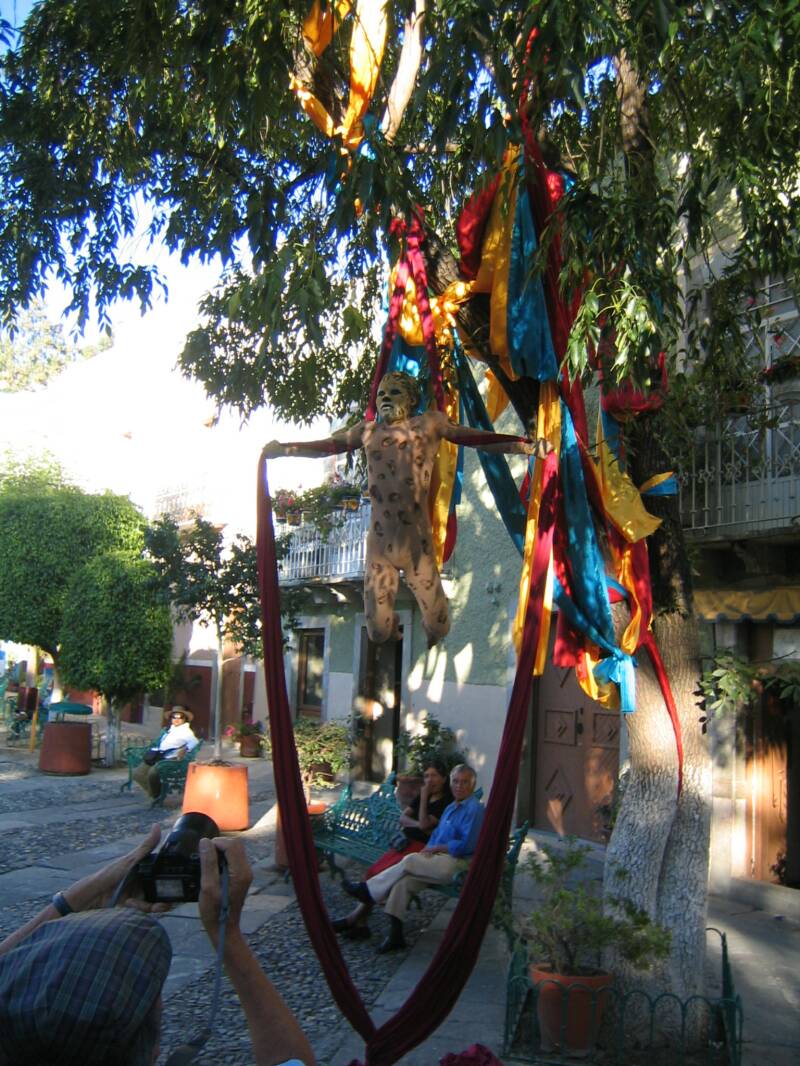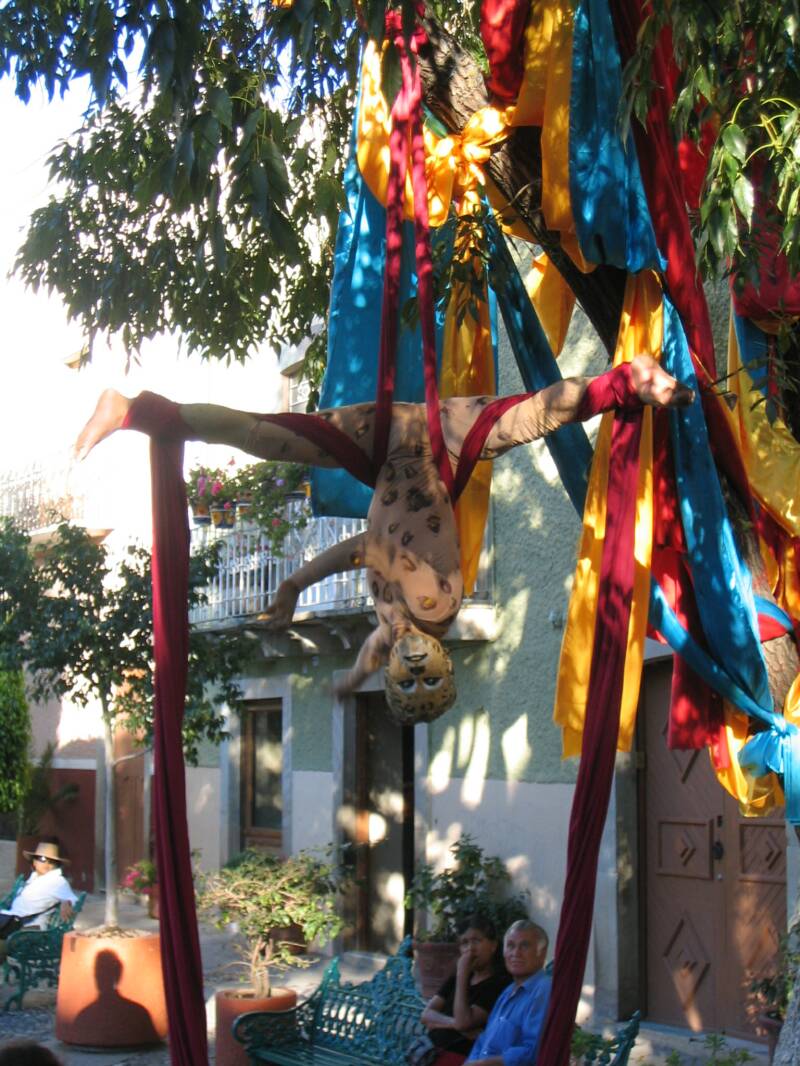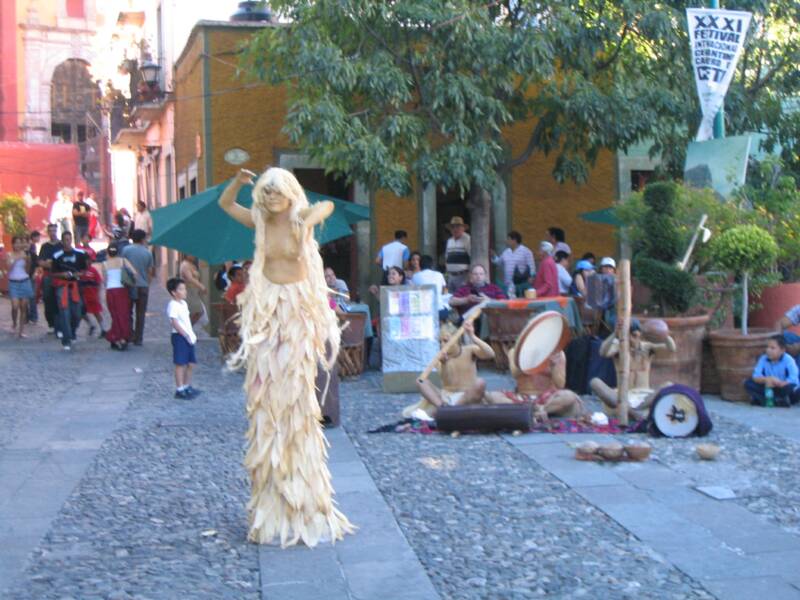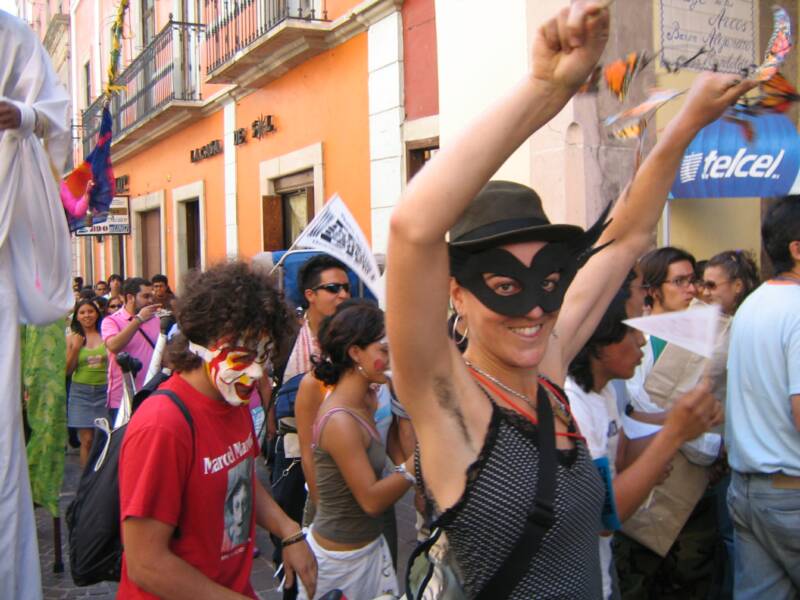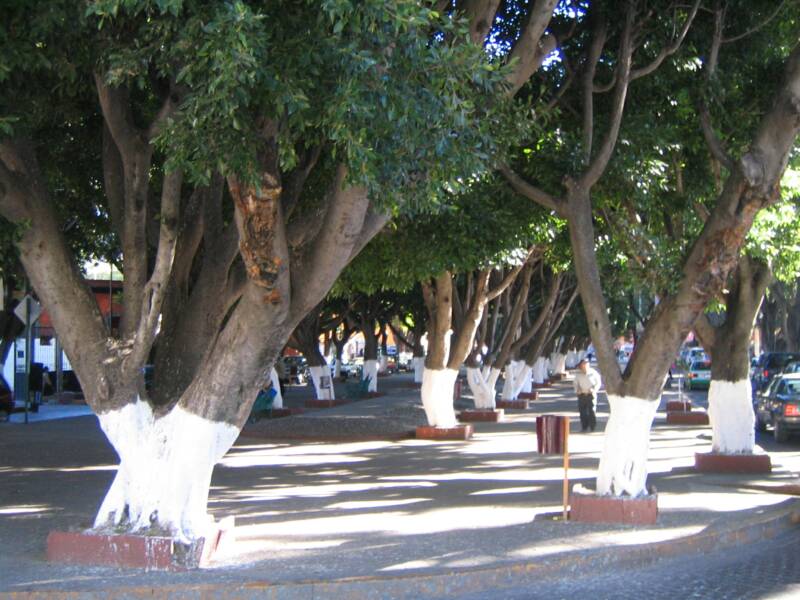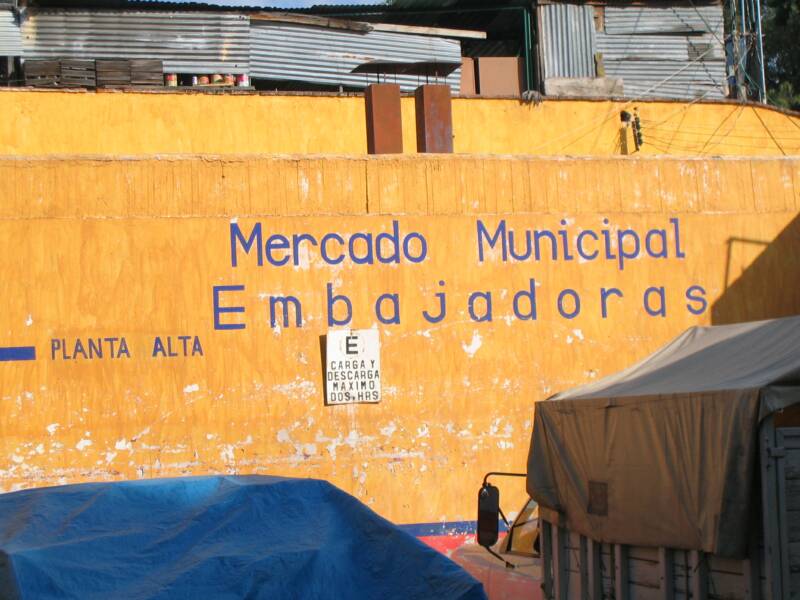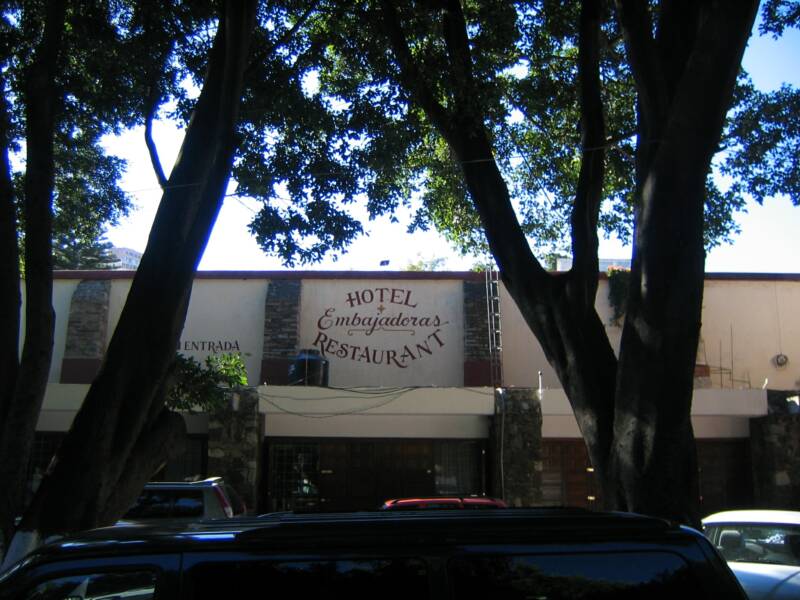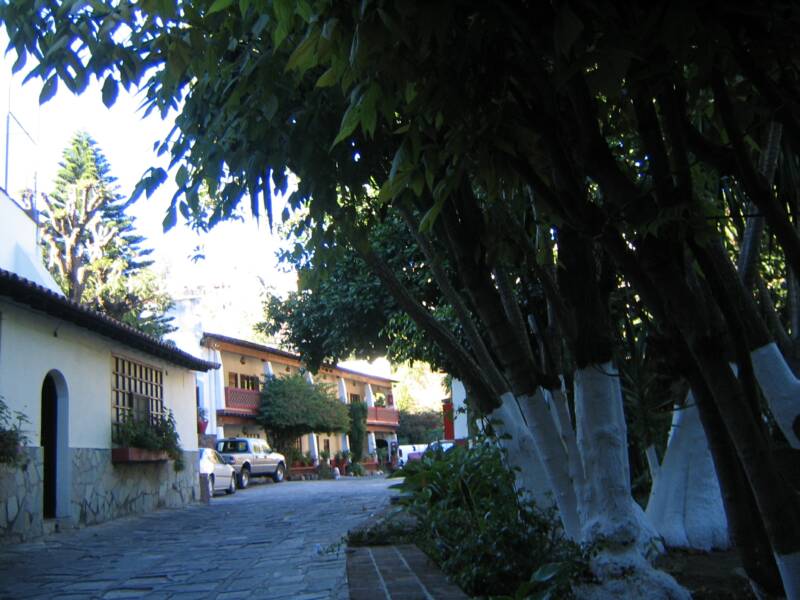 | ||||||
Guanajuato
Hotel Posada Santa Fé
My first hotel here in Guanajuato, about 8 years ago. Prime location at the back of the Jarden and the only on-site parking in the town center.
Lobby is beautiful with tiled walls and large paintings. Unfortunately, rooms are very plain and very loud. But, you can’t beat the location.
Hosteriá del Frayle -
Hotel has large, dark rooms, well off the street, shielding guests from some of the street noise.
No parking within miles.
Restaurants
Posada Santa Fé
The Bay trees were branching into the cafe. I got a front table facing the fountain
and enjoyed the view and my first meal in Guanajuato.
A glass of good, red wine was $40p. I chose the Pollo a la Parrilla, ($69p) the "broiled half chicken" with salad. Might have been starved from my mid-day, five-hour bus ride from Mexico City, but what was actually a double chicken breast, was grilled to perfection.
Casa Valadez - across from Juárez Theater, on Jardin de la Unión
attentive staff and good food make Casa Valadez so popular.
Breakfast menu is small, but with all the favorites. One of the accompanying sauces nearly knocked me out when placed on my table.
The Cream of garlic was delicious. Sorry the serving spoon was so small.
I've noticed most Mexicans don't eat eggs for breakfast, but order from the Antojitos menu, often a variety of Chilaquiles or Enchiladas.
The Huevos Mexicana had the thick-slabbed bacon scrambled with eggs, tomatoes, onions and serano chiles. Next day I requested the delicious bacon on the side.
Rest of menu is vast. Besides a full bar, there were many appetizers, soups, salads, pastas, chicken, steaks, fajitas and sandwiches. The hamburgers were offered with beef or chicken, a nice touch.
Returned for a quick lunch of chicken sandwich and fries. $39p Had hoped expected a bollio roll, and got toasted white bread.
First time I realized catsup is not like ours in the states. The "catsup" was a translucent sauce, lacking any consistency with little tomato flavor.
La Carreta - (The Wagon Wheel) Ave. Juarez #96
Then noticed a woman grabbing balls of corn meal dough,
hand pressing them and grilling the best tortillas eaten.
but I noticed the very large portion of Spanish rice and cabbage slaw.
In my opinion, "The wing is king!" and if El Carreta starts serving a plate of wings,
I am moving to Guanajuato.
Tasca de la Paz
the statue at La Paz gardens, La Basilica and the strolling masses.
On Sunday afternoon, there was a very long wait for a table.
Mexicans, like Europeans, do not eat and run.
After meals, there is always coffee, anytime, day or night, and several cigarettes.
Tasca offers many Spanish specialties like pasta, Paella, Tapas, and Tortilla Española, a Spanish, potato omelet. Most Mexican dishes were also on the menu.
The Saladitas, saltine crackers, seen in photos, are worthy of a place in your suitcase.
Can't read and don't want to know the ingredients.
Compared to crackers at home, these are both a little sweeter and slightly saltier.
They are also as flaky as a croissant wafer.
I had the grilled chicken breast, deliciously served with fries.
Mexico has fortunately not discovered frozen, bagged fries. 
The "catsup" was awful, forcing me to try the salsa in the bowl.
t was like a chile marmalade, thick, rich and not too hot.
I've always said, and especially about Tasca de la Paz, "The longer the wait, the better the food."
El Gallo Pitagorico - Walk south, out of El Jardin, veering to the right, past and San Diego church and take blue stairs marked "El Gallo." Hours are noon-ish to 2 pm.
The Italian cuisine will bring you back.
Antipasti - Several Focaccias, including one with Prosciutto; numerous Catpaccios
Primi Piatti - (First Plate) - a variety of salads
Zuppa - (soups) 2 minestrones and gazpacho
Paste - several Lasagnas, Ravioli and Tortelloni; more than a dozen sauces for a variety of pastas
Secondi Piatti, (second plates)
Two fish dishes, plus shrimp and octopus entrees; three chicken dishes; numerous steak dishes, including Saltimboca.
garlic, cayenne pepper and curry.
The variety of vegetables was grilled, al dente, to perfection. Each slice of zucchini, eggplant, red and green peppers had slight grill marks on both sides. The chef was a miracle worker with vegetables.
Yes, I saved the best for last.
Sights of Interest

100%
Sponsor
Free
Teatro del Arte - Guerreo
A group of four, including two men in 17th-century Spanish society drag, performed an elegant drama to Elizabethan music. The group sang and danced. Thank God for drama queens!
Jesus Alegria Yanavico - Perú
Escena Alternative - Venezuela
Circosicletas - Austin, Texas
www.bikesacrossborders.org
On the Streets
Callejoneadas
The callejoneadas encourage the mauraders to join in the singing and dancing. During the festival, crowds prevent roaming, but not the fun.
Tours sometimes offer callejoneadas, usually with an over-worked burro, carrying a picturesque wooden keg of tequila. The group stops often for more songs, while delirious dancers refill their drinks.
These young, student, musicians
Peso por Beso - 10 cents a Kiss
A very handsome, shirtless man was standing at the edge of El Jardin, holding a sign and attracting quite a bit of attention. Upon closer inspection, (not him, of course,) the sign read "De a Peso, el Beso -- o Manoseado," or, "For a Peso, a Kiss or Caress."
Later, sitting at a street cafe, a beautiful, young woman from Durango asked me, in perfect English, if she could take my photo.
When they used their camera, I handed them mine. How could I refuse?
Living Statues were everywhere. Some changed costumes and acts daily. Others were becoming institutions on certain corners.
All had signs requesting donation for a photograph. One required "No Photos, please."
Others flowed with motion, welcoming the crowds to join them for a group photo.
Fit for a King
His only purpose was to grant his subjects the privilege of kissing his royal ass.
His act was the art of persuasion. The dialog was usually successful, much to the laughter and screams of approval from the crowds.
Costumes for Rent - (by the minute)
For 5 pesos ($.45) a person, revelers could rummage through the suitcase and dress accordingly. He would then take your camera and snap your photo.
Art -
One was of the duo crusading through Guanajuato's famous tunnels. Didn't seem to be much of an art market.
Last Day of Festival
On the last Sunday of the festival, crowds have thinned very little. Sober. faced revelers were carrying handmade signs reading, "Ride to Mexico City, $100p," or "Need ride to Guadalajara."
The bare-breasted mermaid was wearing a bra. Living Statues have changed into their last costume. And I made next year's motel reservations!
http://festivalcervantino.gob.mx/fic07-pre/
CLETA -
www.cleta.org/encuentro
artcleta@cleta.org
Festival International Cervantino
The Cervantes Festival is one of the largest performing arts festivals in the Americas, and maybe the world. The festival started in the 1950's when students performed scenes about Don Quixote and Sancho Panza. No where is Dulcinea seen, mentioned nor celebrated. No, Manuel Cervantes never visited Guanajuato, but nowhere is he celebrated more.
Hundreds of performances from most countries around the world are represented. Japan's famous percussion ensemble, GOCOO + GORO, brought their fiercely contemporary, yet traditionally Japanese music to Guanajuato. Their drumming was on soundtrack of "Matrix: Reloaded."
This year (2005), the Yucatan was highlighted. (It was a terrible irony because this weekend,
Hurricane Wilma is scouring the Yucatan Peninsular.)
Guest of honor was Yucatan Musician Armando Manzanero, one of the greatest romantic composers of our times. A well presented, if slightly commercial, exhibit of foods, crafts and products was displayed.
Always the middle two weeks in October, I arrived on Thursday for the final four days of the Festival. The Executivo Bus from Mexico City was only half full, but the road into Guanato was busy. I had reservations at my hotel and I got the last room. Most hotels were full. The restaurants around El Jardin were also full. Sidewalks were crowded, but now not full.
On Friday, the sidewalks were full. Many sidewalks and roads are pedestrian only. Street sidewalks were too narrow and people started using the streets. Saturday, the crowds took over the streets, too. There was a thick carpet of Revelers as far as the eye could see. Everything was full, but I never saw any pushing or panic anywhere. It was a very calm mob scene. Everyone seemed to be enjoying themselves.
Performing Arts - There is an official schedule available at all information booths.
Most performances were free.
Tickets for official performances can be purchased behind Juarez Theater or Ticket Master
and range in price, including FREE.
Tickets for Teatro Libre, "Free Theater," were $20US!
Jesús Alegria Yanavico - dancer
CLETA
CLETA is a Cultural - Political Organization that schedules most of the free Performances. Like a juried Art Festival, all performers must apply with resume, description of performance and photos or video of their work.
Seven different Plazas are scheduled from noon to midnight. There were many unscheduled acts as performers moved between the Plazas.
I started doing the same by devising a circuit of my favorite Plazas. Guanajuato is all hills and the walk gave me a chance to see more of the picturesque town and get needed exercise. Wither it be rock bands, provocative dance, rhythm drums, comic monologues, puppet shows or agile, athletic, acts, it was all cutting edge performances, and, all FREE!
Plaza San Fernando was a favorite. One could sip a glass of wine at Restaurant Van Gough's Ear
or grab a snack at the other cafes on the shaded Plaza.
One evening, in front of my table, was CLETA's scheduled performance.
To my right was a large group of well-practiced drummers. On my other side, a rope had been tied between two trees and a dude was doing a balancing act. In one corner, a plethora of colorful material hung from a tall tree with a well-toned man doing a mid-air ballet. Behind me, a Mariachi band was patiently waiting for their turn to play. And standing at my table was the cutest, five year old girl, trying to sing for a peso.
Poor thing couldn't sing for all the money in the world, but she got my peso.
So much of the performing arts are impossible to describe or even interpret, but this is how I saw it.
Ovejas Negras - Yucatán
The four female creatures I saw at the entrance to the Plaza were motionless for about an hour.
Their costumes were aboriginal-ish.
In the middle of the Plaza, a ten-foot tall mermaid, with cornhusks for fish scales, and looked bare breasted, (she wore leotards,) arms in constant movement, welcomed everyone to their world.
As the group emerges into jumps and orgasmic screams, the mermaid of the world continues to remind us that life is art.
Guanajuato Hotels
During the Cervantino Festival, hotel rooms are at a premium.
I've had reservations for about eight months.
Reservations must be repeatly confirmed. Two women on my bus here arrived at another hotel only to find their reservations lost. They found other expensive accommodations, hated their room and left.
Also during the Festival, bars are jammed, restaurants are busy and performers are on every corner. Guanajuato is alive with the arts.
Rest of the time, Guanajuato is a quiet college town.
Hotel Las Embajadoras
Hotel Las Embajadoras is located on Embajadoras Park and across the park from Mercado Embajadoras. with a tunnel marked "Embajadoras."
Sleep during Cervantino Festival is usually difficult, especially in the central hotels. The nighttime music, noise from the crowds, and the early morning church bells can keep the dead awake.
Las Embajadoras is geographically shielded from nearby sounds. Closest church bells are distant.
ph# 011-52-473-731-0105 (from US)
ph# 01-473-731-0105 (from Mexico)
Guanajuato was once a prosperous capital of the Spanish colony, and later during the dictatorship of Porfirio Diaz, it had a second glory period as the mines again became a source of great wealth. The Mexican independence started here in this region. The father of Mexican Independence, Miguel de Hidalgo, led about 80,000 farmers and miners to this city in 1810 to attack the Spanish authorities. He was captured a few months later and his head hung with some other rebels on the outside of the granary (today the same building is a great museum of Mexican Independence, well worth a visit). But years of guerrilla war ensued, and by 1823 Mexico was independent. Interesting to contextualize Mexican independence in the same period with the French Revolution, the Haitian revolution, and not long after the U.S. emerged from British colonialization; also, this region, Guanajuato-Bajio, was the economic powerhouse of Mexico in those times, so it's little wonder at the birth of capitalism that the successful merchants and mine owners would contribute to the political movement against colonization.
Somehow, urban planners in the 1950s had the foresight to realize that the charming alleys, stairways, plazas, and narrow streets should be preserved and enhanced. Today, Guanajuato is a designated World Heritage Site by the United Nations, and it retains an incredible old-world charm, reminding visitors more of an Italian city than anything seen in Mexico.

